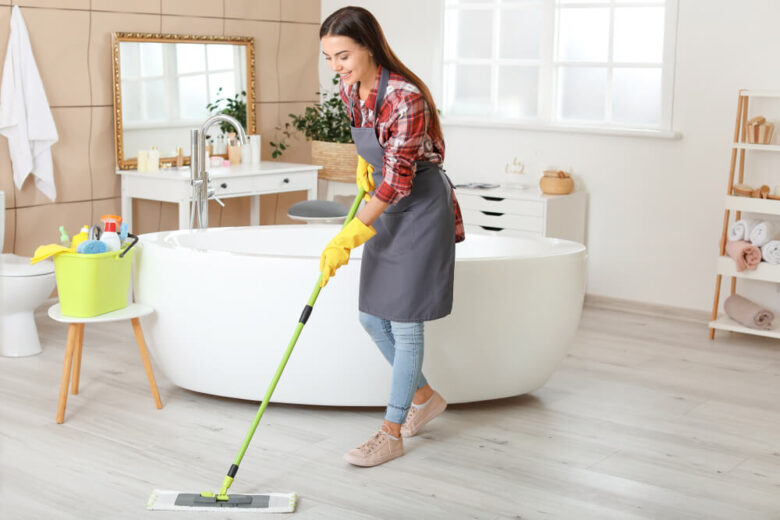The difference between a regularly cleaned bathroom and a well-maintained bathroom is in the little things. A spotless bathroom not only shows how clean you are, but also gives residents and visitors the feeling that the space is safe and healthy. Based on years of professional cleaning experience, this updated guide gives you a detailed plan to keep your bathroom spotless. It includes daily, weekly, monthly and yearly tasks, as well as advanced tips and more general questions.
Daily Care for Long-Lasting Cleanliness:
Every day offers new opportunities to keep your bathroom clean and smelling great. Start by wiping down surfaces to keep countertops and fixtures dry and clean. Next, make sure that the parts of the mirror that people often touch, such as light switches, faucet handles and door knobs, are spotless and disinfected. Routine maintenance prevents the buildup of bacteria, soap scum and water stains, making weekly cleaning easier.
Clean thoroughly Once a Week to Create a Dust-Free Space:
A weekly deep cleaning can remove dirt and grime that regular care may have missed. This includes scrubbing the shower or tub to remove soap scum and mould, cleaning the toilet and the area around it to keep it clean, and carefully mopping the floors to remove any dirt, hair, and other debris . Cleaning your shower walls with a squeegee after each use will reduce water stains and small buildup, keeping the area looking clean and new.
Monthly Checks and Balances:
Monthly tasks are intended to solve and prevent possible long-term problems and keep your bathroom clean and useful. It’s important to clean your gutters so the water can flow smoothly, empty and organise your closets so you can quickly find what you need, and throw away old or damaged items. In addition, shower curtains and covers should be cleaned or replaced regularly to prevent mould growth.
Try to Clean Your Space Every Three Months:
Quarterly maintenance includes tasks that are important to keeping your bathroom beautiful and structurally sound. Thoroughly cleaning and resealing grout lines will not only keep your tiles looking new but will also prevent water damage. Sealing tubs, showers and sinks should be inspected and repaired regularly to prevent leaks and water damage. If this is not done, repairs can be costly.
Perform Thorough General Maintenance Once a Year:
Annual maintenance inspections include chores that improve the overall safety and functionality of your bathroom. Thoroughly cleaning your exhaust fan will ensure that it removes moisture and prevents mould growth. Adding new decor can give a room a new look and feel, making it feel warmer and more welcoming. Make the room safer by checking and replacing damaged electrical components to prevent water and electricity from mixing.
Professional Tips for the Future:
Choose a Natural Air Freshener: If you want to keep your bathroom fresh without using harsh chemicals, you can use an essential oil diffuser or baking soda.
Make It a Habit to Tidy Up: Regularly cleaning your bathroom not only makes it easier to clean, but it also makes it a more relaxing and enjoyable place. Use storage options to keep the counter tidy and toiletries organised.
Invest in Water-Efficient Fixtures: Faucets that use less water help prevent hard water stains and help protect the environment.
Conclusion:
Keeping your bathroom tidy requires more than just cleaning. You have to make it a habit that will work for the rest of your life. With these pro tips, you can keep your bathroom clean, healthy and inviting by incorporating them into your daily, weekly, monthly and annual maintenance routine. By knowing what needs to be done and using the right tools and methods, you can keep your bathroom clean quickly and easily. Follow these tips and you’ll enjoy the peace of mind that comes with a spotless bathroom.
FAQs:
1. How do you effectively clean shower glass and prevent water stains?
For cleaning shower glass, a solution of equal parts white vinegar and water is effective. Spray it on the glass and wipe it off with a microfiber cloth. To prevent future water stains, apply a rainproof product designed for car windows to clean the glass; this helps the water to drip and roll away.
2. Is it necessary to use bleach to keep your bathroom spotless?
While bleach is effective at disinfecting and whitening, it is not always necessary for a spotless bathroom. Alternatives such as hydrogen peroxide, vinegar and steam cleaning can provide excellent results without the harshness of bleach, making them safer for your home and environment.
3. How do you keep your bathroom spotless with hard water?
Hard water causes problems due to limescale and mineral deposits. Installing a water softener system can significantly reduce hard water problems. While cleaning, regularly applying a vinegar solution to the affected area can help dissolve the deposits. Wiping surfaces after use can also prevent the buildup of hard water stains.
4. What professional tools do cleaners recommend for a spotless bathroom?
Professionals often use microfiber cloths because of their versatility and effectiveness at retaining dirt and bacteria. It is recommended to use a squeegee to keep shower doors and walls free of water stains. High-quality rubber gloves protect the skin from cleaning products, while a long-handled brush makes it easier to reach difficult areas without straining.
5. Can I keep my bathroom spotless without spending a lot of time on it?
Yes, by implementing an effective cleaning routine and using the right tools and products, you can keep your bathroom spotless without having to spend time on it. Routine cleaning, such as wiping down surfaces and using a squeegee on the shower door, as well as an intensive weekly clean, can keep your bathroom looking its best with minimal time investment. Organising cleaning supplies and keeping them easily accessible in the bathroom can also simplify the cleaning process.

